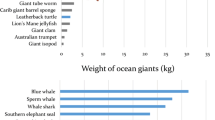Abstract
THE recent resurgence of speculation about dinosaur physiology and behaviour has resulted in two notable and debatable interpretations. Bakker1 summarises evidence of several investigators and concludes that dinosaurs were endothermic. Coombs2, among others, suggests that the sauropod dinosaurs were mainly terrestrial, only occasionally entering shallow water. These hypotheses might well be viewed in the light of one line of evidence concerning the relationship between height of animals and hydrostatic pressures in the vascular system. Size alone can provide important insights into dinosaur cardiovascular performance which necessarily relates to the questions of endothermy and habitat. This report shows firstly, that high arterial blood pressures in large dinosaurs are consistent with the proposal that they were endothermic. Secondly, I suggest that if the long-necked sauropods were aquatic, they thereby avoided tremendous hydrostatic stresses on the cardiovascular system.
Similar content being viewed by others
References
Bakker, R. T., Scient. Am., 232, 58–78 (1975).
Coombs, W. P., Jr, Paleogeogr., Paleodimatol., Paleoecol., 17, 1–33 (1975).
Rodbard, S., Brown, F., and Katz, L. N., Am. Heart J., 38, 863–871 (1949).
Johansen, K., Resp. Physiol., 14, 193–210 (1972).
Geddes, L. A., The Direct and Indirect Measurement of Blood Pressure. (Year-book Medical Publishers, Chicago, 1970).
Bakker, R. T., Evolution, 25, 636–658 (1971).
Bennett, A. F., and Dalzell, B., Evolution, 27, 170–174 (1973).
Feduccia, A., Evolution, 27, 166–169 (1973).
Prosser, C. L., and Brown, F. A., Jr, Comparative Animal Physiology (Saunders, London, 1961).
Bakker, R. T., Nature, 238, 81–85 (1972).
Ricqlès, A. de., C.r. hebd. Seanc. Acad. Sci Paris, 268, 782–785 (1969).
Hohnke, L. A., Nature, 244, 309–310 (1973).
Lasiewski, R. C., and Calder, W. A., Jr, Resp. Physiol., 11, 152–166 (1971).
Van Citters, R. L., Kemper, W. S., and Franklin, D. L., Science, 152, 384–386 (1966).
Goss, R. J., in Cardiac Hypertrophy (edit. by Alpert, N. R.), 1–10 (Academic, New York, 1971).
Clark, A. J., Comparative Physiology of the Heart (Cambridge University Press, London, 1927).
Sandler, H., and Dodge, H. T., Circulation Res., 13, 91–104 (1963).
Kurtén, B., The Age of the Dinosaurs (World University Library, London, 1968).
Romer, A. S., Vertebrate Paleontology (University of Chicago Press, 1945).
Author information
Authors and Affiliations
Rights and permissions
About this article
Cite this article
SEYMOUR, R. Dinosaurs, endothermy and blood pressure. Nature 262, 207–208 (1976). https://doi.org/10.1038/262207a0
Received:
Accepted:
Published:
Issue Date:
DOI: https://doi.org/10.1038/262207a0
- Springer Nature Limited





